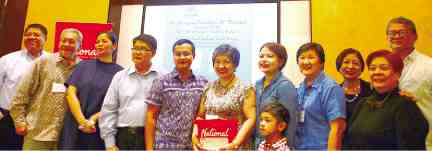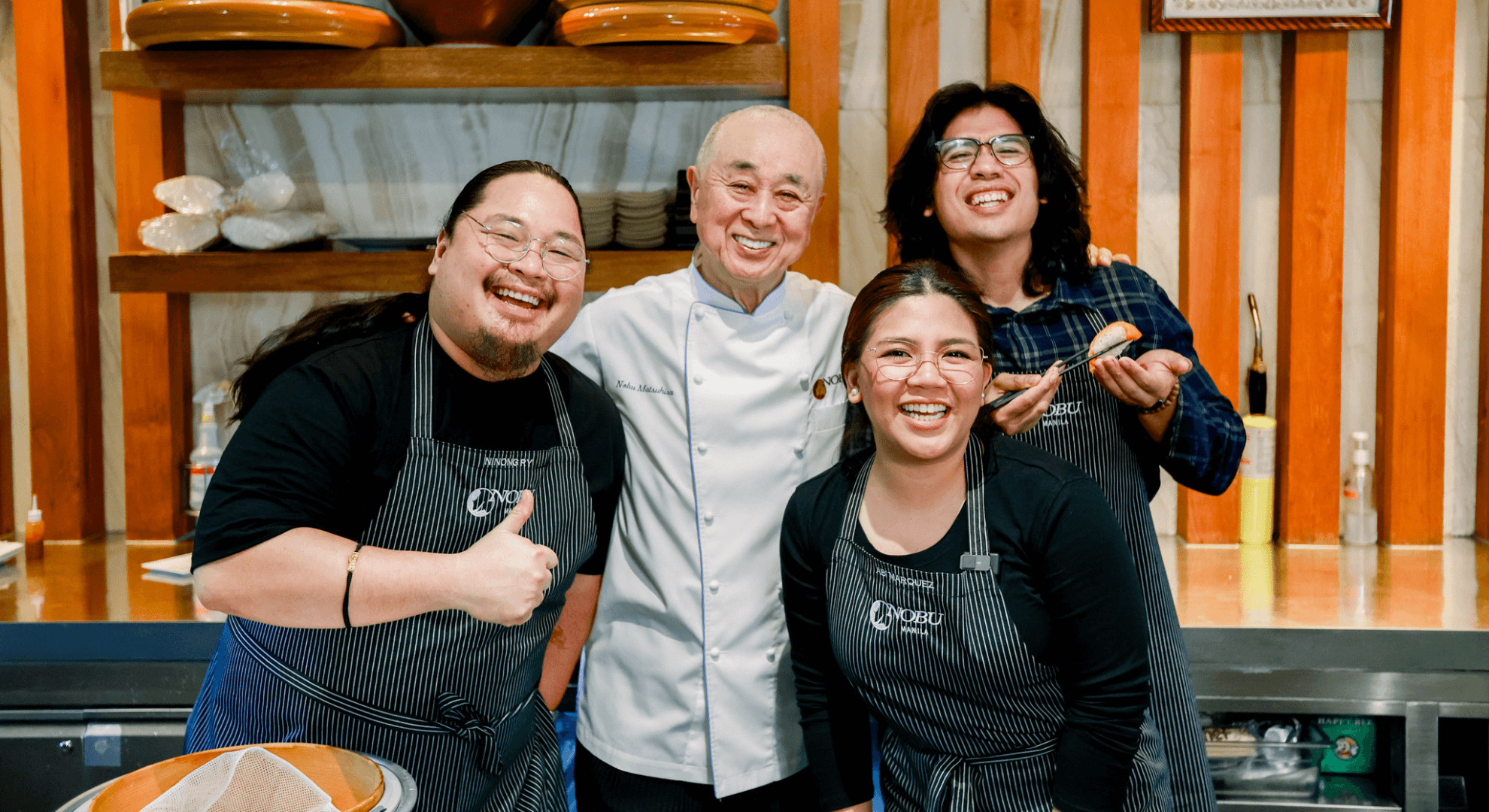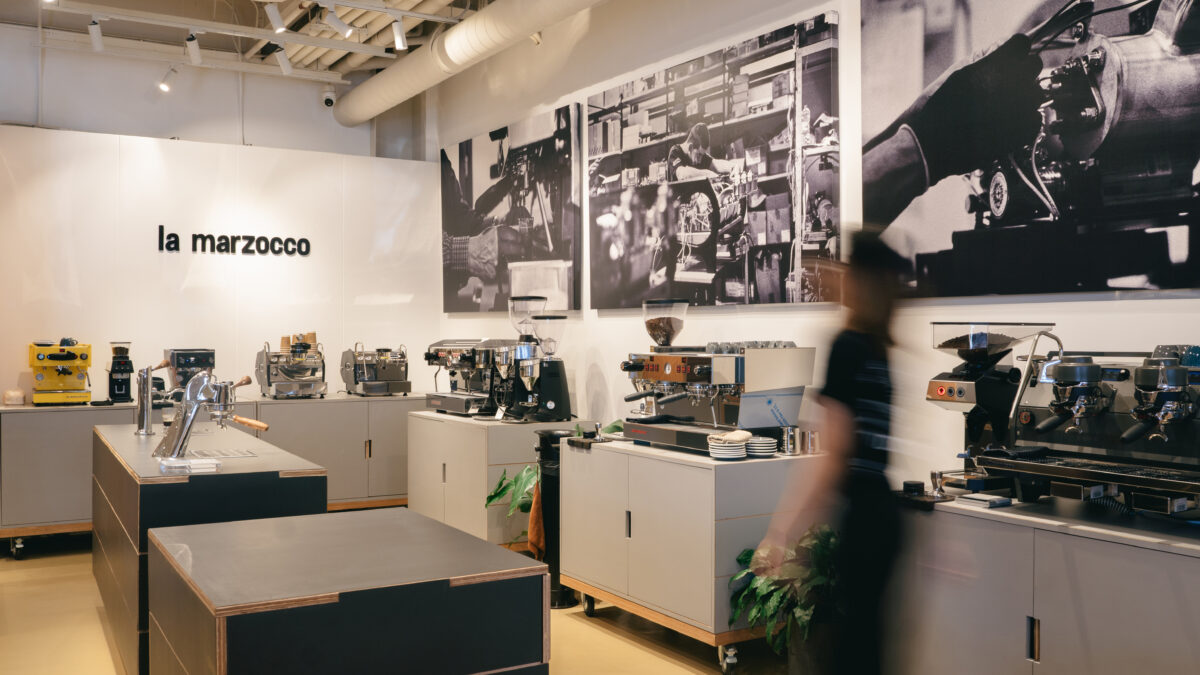
Maria and Cora Alvina, as well as speakers Micky Fenix and Claude Tayag
The annual August rains didn’t diminish the crowd that trooped to the Philippine Readers and Writers Festival of National Book Store at its sponsor hotel, Raffles in Makati, last week.
The halls were filled with people waiting to get into the conference rooms and the ballroom to hear writers talk about their craft. I was honored to be one of the speakers for food and travel, together with friend and colleague Claude Tayag.
My talk was on my evolution as a food writer. Initially, I told the audience, I did general food subjects, writing about sans rival, moon cake, what office people ate.
Restaurant reviewer
My first article about the food industry was about Nora Daza. She was closing down her restaurant in Ermita since the place was going to seed, and I wrote a piece I titled “Is there life after Au Bon Vivant?”
I was encouraged to keep writing by E. Aguilar Cruz, writer and bon vivant, who said he liked my story.
My next food writing stage was as a restaurant reviewer. The “free lunch” wasn’t worth it because not everything was worth writing about. And you got flak from people who disagreed with your assessments, some even hinting I was a paid hack.
Everyone is a food critic, which is why it’s easy to blog about food when all you have to say is that you liked or disliked the dish and the service. I wish, however, that bloggers go beyond the nice photos and captions and write about the dish beyond its look and taste and more about its traditional history, or the chef and his looks and so-called talent.
Research is easy in today’s digital world, but, back then, all I had were my books and my genuine interest in interviewing. I never wrote a bad review. I adhered to Doreen Gamboa Fernandez’s dictum that one shouldn’t do a negative review because you can destroy a business. Better not to write anything at all.
The path to writing about regional cuisine opened up to me when I was tasked to do the book “Philippine Cuisine: A Country’s Heritage” for Monterey Corp. I told the sponsors I wasn’t going to be an armchair food writer; I had to go where the food was and that we had to photograph at their native locations because sunlight quality was different at every place. Well, I just invented that last excuse so I could travel.
Travel is a natural adjunct to food writing, and there is a rule one must always follow. Know something of the place before you even get there. Again, research is important. When I began, there was no internet or cellphones. But there was a “lifeline”—calling friends who lived in the place I intended to visit and asking them what I had to look out for.
Stop, look, listen
When you are at the place, one must do what is recommended when crossing a train station: stop, look, listen. Before resting for the night, stop and take stock of what you learned, you saw and you heard. Look around and draw something from the environment and the people.
You will always learn about the culture, such as how people eat and cook. Listen to what they have to say, because you will always find things you’ve never even heard of or knew about. That’s how I discovered the salt block tultul or duldul when I visited Iloilo, and then found the maker in Guimaras.
Travel hasn’t been only domestic; I’ve been fortunate to have been invited to go to other places, most recently Spain. I’ve also been to France, Israel, Sweden, Amsterdam, Copenhagen, Thailand, Singapore and so on. Every experience in those places is still vivid in my mind, not to mention written about in my columns.
Some of my column pieces on local cuisine became a book, while others are still in the back burner. The publishing world was the next step, as I became editor of a culinary magazine, Food, and culinary books like “Kulinarya,” “Panaderia” and “Savor the Word.”
The next stage in my career has turned out to be as an agricultural journalist. I only realized I have become one when, on this last trip to Spain, I met a speaker who headed an association of journalists like her. With today’s trend of “farm to table” cuisine, everyone is writing about the table, but no one writes about the farm.
And I think I had been prepared for this when I was invited to Iowa to write about the place where much of America’s food comes from, to New Zealand to find out how kiwi fruit is grown, to Bordeaux and California to learn more about the art of growing “wine,” to Spain to know how jamon is made and the big facilities that process frozen pork parts and sausages, and to our local organic farms to learn about their methods.
Traceability
The most important word today in agri-products is “traceability,” or knowing where the product was sourced, when it was harvested, where it was packed.
It seemed apt that my talk on food and travel ended with the awarding of the winners of the Doreen Gamboa Fernandez Food Writing Award. First place went to two veteran winners, Elmer Nocheseda and Lolita Lacuesta, both established writers.
The two second placers were first-time contestants. Raymond Aquino Macapagal now teaches Food Studies and Gastronomy, two subjects unheard of in my time. He has a master in food culture and communication from University of Turin and is working to restore indigenous granary houses in Batad Rice Terraces cluster, a Unesco World Heritage site.
Joyce Roque is pursuing her MFA in creative writing at De La Salle University, but she has worked in media here and in Shanghai, China. She wrote about how her fondest memory is attending a class under Doreen Gamboa Fernandez on writing about culture.
The winners received cash prizes and books from Anvil Publishing, and were treated to lunch at the Spectrum of Raffles Hotel.
Mind-boggling
The Philippine Readers and Writers Festival had several invited speakers, including three American fiction writers. It boggles the mind to learn that they are best sellers in the billions, their work mostly downloaded as digital reads. They all talked about how they started and the process of writing.
Anna Todd, author of the series “After,” and Paula McLain, author of “The Paris Wife,” seemed to both take after “Harry Potter” author J.K. Rowling. They were not writers to begin with; they just sat down one time to write, and the stories just flowed out of them.
McLain based her novels on real people like Ernest Hemingway, and her second book “Circling the Sun” on the main characters of “Out of Africa,” Denys Finch Hatton and Karen Blixen.
Adam Johnson, who teaches literature in San Francisco, wrote about North Koreans—an imaginative tale set in a secretive country that he had visited.
Those three represent the new romance novels of today’s readers.
E-mail pinoyfood04@yahoo.com.












































